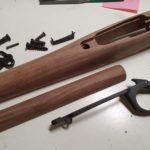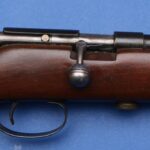One of the luxuries of being a firearms collector, is that I’ve made a lot of good purchases over the years, and unfortunately few bad ones too. My first firearm that I ever purchased was a Remington 597 in 22 LR, and I would say this was my first bad purchase. Since purchasing this rifle, it has never functioned quite right. With the frustration of having a rifle with feeding and extraction issues, I eventually went out and purchased my next rifle, a Henry Golden Boy, and then the next rifle, and the next rifles, and so forth and so on. My Remington 597 was relegated to a safe queen.
I’ve always held on to my 597, as being my first firearm, I wasn’t not quite ready to give up on it. I would bring it out every so often to see how it functions, to let friends try it at the range, maybe to see if it would eventually break in and be a worth wild purchase. Sadly, the same issues would constantly rear it’s ugly head, and then the gun would go back into the cabinet.
Since taking up posting videos to Youtube, I’ve been lucky where I’ve received a lot of great feedback, some of the best feedback I received is when I did my Ruger 1022 vs Remington 597 video. I received many suggestions on how to optimize the Rem 597. I decided this was going to be my last try at getting this rifle to run right, if I couldn’t, my Remington 597 would have a date with the metal chopsaw!
I ordered a replacement hammer and extractor from Milarm, in Edmonton, as they’re the Canadian distributor for Volquartsen Custom part. However, before swapping the extractor and hammer, I wanted to try other options to see if I could optimize my rifle, and over the next few videos I will go through different steps to try and improve its reliability.
Step 1 – Sanding the magazine body and follower
The first step in my quest to optimize my rifle, was to see if I can solve the issue where rounds were not being fed properly from the magazines. I received more then a few comments about sanding down the inside of the magazine body and follower to make sure there were no burrs or high spots that might impede feeding.
https://www.youtube.com/watch?v=kXJOkyosNIo
Step 2 – Polishing the Guide rods
I found that after sanding the magazine bodies, functionality didn’t really improve much, if any. The next suggestion that I received from several viewers, was to sand down and smooth out the guide rods of the bolt carrier.
https://www.youtube.com/watch?v=dJ8cEGwmJTY
I had the same results after sanding the guide rods; functionality of my rifle didn’t improve much, if any. I would still have the same periodic feeding issue, the extraction issue was still there, and it was starting to get a bit frustrating. It’s been a long time since I gave this rifle this much attention and, as expected, it was letting me down.
Step 3 – Swapping the extractor
This was the last chance for this gun, I still had to swap out the extractor and hammer to see if things improved.
https://www.youtube.com/watch?v=39Kbwm7sSPQ
Swapping the stock extractor with the Volquartsen Custom extractor had made a huge difference! Prior to the swap, I was lucky if I was able to get through one magazine without a snag up. After the swap, the extraction issue was almost completely gone and now the only real issue that remained was feeding problems, with the occasional round getting snagged up, before being chambered.
There is one caveat with the swap: I can’t say 100 percent for sure that the swap was what solved all my problems. While I had the old extractor out I gave the bolt a through cleaning, and I removed 1000’s of rounds worth of junk that had built up around the extractor slot, as well as gaving the area around the extractor a light sanding to remove any high spots. So it’s possible that a combination of efforts fixed the issue.
Step 4 – Swapping the Hammer
https://www.youtube.com/watch?v=RgzapF32ClM
The last modification I made to my Remington 597, was to swap out the stock hammer with one made by Volquartsen Custom. A few people made the recommendation, suggesting that it would reduce my trigger pull and make the rifle that much smoother to shoot. While swapping the hammer was straight forward, I didn’t really notice any difference when I was out shooting.
I’m glad that I performed the parts swap; the before and after made a huge difference and gave this one gun another chance. My next project for this rifle is to try and eliminate the feeding issue to see if I can get rid of the occasional hangups, either by more polishing of the magazines or by doing an audit of the magazines. For my audit, I will number them when at the range shooting and document any time there is an issue, if I notice a pattern of one magazine causing more problems then the others, I will discard that magazine.
I look forward to getting out to the range a bit more often with my first firearm purchase!










